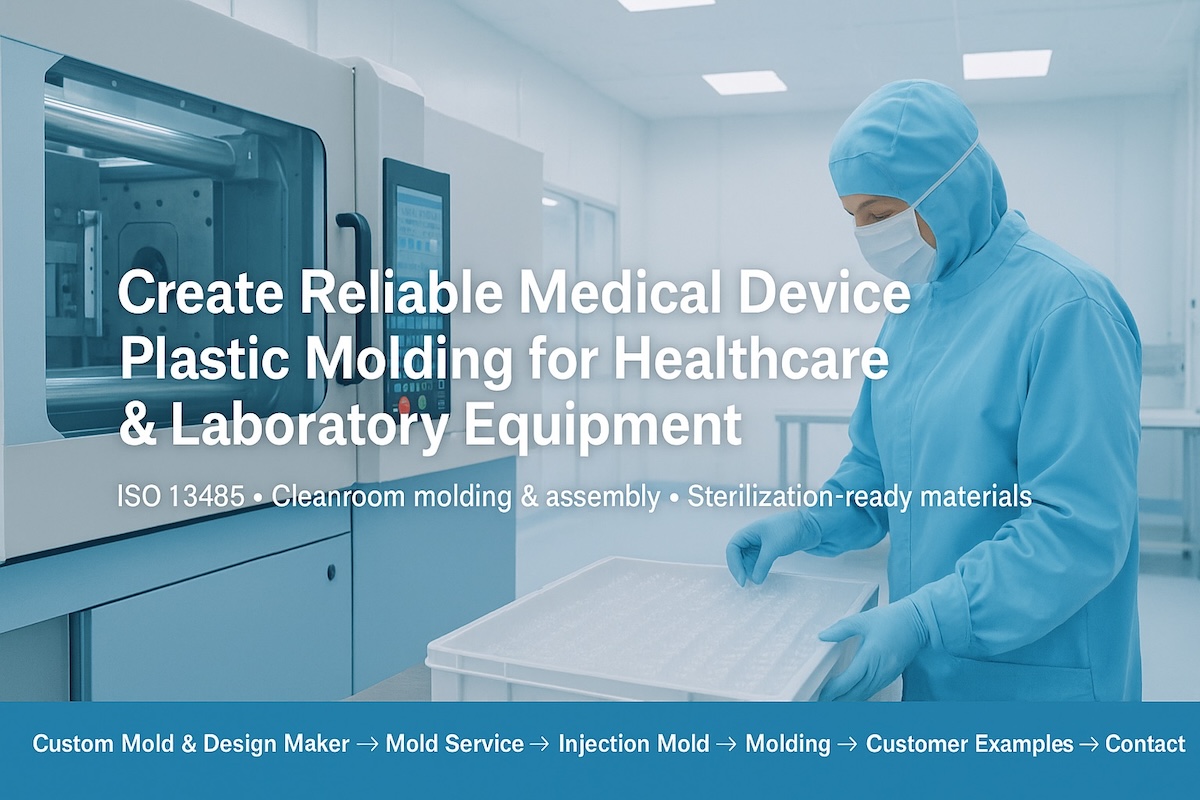Create Reliable Medical Device Plastic Molding for Healthcare & Laboratory Equipment
Create Reliable Medical Device Plastic Molding for Healthcare & Laboratory Equipment

Create Reliable Medical Device Plastic Molding for Healthcare & Laboratory Equipment
ISO 13485 discipline • Cleanroom molding & assembly • Sterilization-ready materials
Building plastic parts for clinical use is not just “good molding”—it’s validated, traceable, and audit-ready manufacturing. Use this guide—and the TaiwanMoldMaker.com network—to move from RFQ to IQ/OQ/PQ with confidence for devices, disposables, and labware.
Explore our end-to-end services:
Custom Mold & Design Maker → Mold Service → Injection Mold → Molding → Customer Examples → Contact
What “reliable” means in medical molding
-
Quality system: ISO 13485 baseline; document control, change control, CAPA, training matrices.
-
Risk management: ISO 14971, design/process FMEA tied to CTQs.
-
Biocompatibility: ISO 10993 material strategy and masterbatch compliance.
-
Cleanliness: ISO 14644 cleanrooms (typ. Class 7/8) with gowning SOPs and environmental monitoring.
-
Traceability: DMR/DHR, lot genealogy, UDI/part marking, label control.
-
Validation: IQ/OQ/PQ with protocols, reports, and golden-recipe lockout on the press/MES.
-
Packaging: ISO 11607 validations (seal strength, dye/microbial ingress) when sterile barrier is required.
-
Data for approvals: Shareable MES dashboards (OEE, CpK, scrap, kWh/kg), first-article (FAIR), and full metrology packs.
Cleanroom molding, assembly, and finishing
-
Press cells: Electric machines with closed-loop temperature control, valve-gated hot halves, cavity-pressure sensors.
-
Assembly options: Ultrasonic/laser/IR welding, UV/solvent bonding, heat staking, press-fit, screw-install with torque control.
-
Inline checks: Vision SPC for dimensions/cosmetics, leak/occlusion tests, functional end-of-line tests.
-
Marking: UDI-ready laser or ink systems; validated inks for cytotoxicity/sterilization exposure.
Medical & labware material quick-guide
| Material (medical grades) | Key strengths | Sterilization compatibility* | Typical uses |
|---|---|---|---|
| PP (homopoly/Random) | Inert, low cost, hingeable | EtO ✓ / Gamma ✓ / Steam ✓ | Pipette tips, PCR plates, syringes, caps |
| HDPE / LDPE | Chemical resistance, low extractables | EtO ✓ / Gamma ✓ | Bottles, closures, transfer sets |
| PC / PC-ABS | Tough, clear (PC), impact-resistant | EtO ✓ / Limited Gamma (discolor) / Steam ✕ | Device housings, guards, latches |
| POM (Acetal) | Low friction, precision | EtO ✓ / Gamma ✕ / Steam ✕ | Gears, valves, luer components |
| PPSU / PSU | High heat, repeated autoclave | EtO ✓ / Gamma ✓ / Steam ✓✓ | Sterilizable trays, handles |
| PEI (Ultem™) | High strength, heat, dielectric | EtO ✓ / Gamma ✓ / Steam ✓ | Surgical guides, manifolds |
| TPE / TPU (medical) | Soft-touch, seals, kink resistance | EtO ✓ / Gamma ✓ / Steam (grade-specific) | Tubing connectors, grips |
| COC / COP | Optical clarity, low autofluorescence | EtO ✓ / Gamma ✓ / Steam (grade-specific) | Microfluidics, cuvettes |
* Always confirm with the exact resin grade datasheet and your sterilization dose/profile.
DFM pointers for clinical-grade parts
-
Geometry: Uniform walls; ribs in place of mass; generous radii to eliminate stress concentrators.
-
Draft: ≥1–2° on cosmetics; more on textured surfaces and soft materials.
-
Gating: Valve gates for cosmetics/vestige control; cold runners for commodity labware with high cavitation.
-
Steel & surface: Corrosion-resistant mold steels (S136/420SS/H13 + coatings); polish levels tied to cosmetic/cleaning needs.
-
Tolerances: Lock critical dimensions to GD&T; plan post-machining for µ-level features if needed.
-
Bonding surfaces: Design weld ribs, energy directors, solvent channels with fixturing datum features.
Process control & metrology (first-time-right)
-
Scientific molding: Decoupled II, V/P transfer by pressure, cavity pressure monitoring, and gate freeze studies.
-
Validation data: DOE during OQ to define the acceptable process window; CpK ≥ 1.33 (or as required) on CTQs.
-
Measurement: CMM + optical/laser scan, surface/gloss/ΔE for visible parts, functional/leak testing with gage R&R.
Example timeline to IQ/OQ/PQ (pilot → ramp)
-
Day 0–3: 48-Hour DFM pack (flow/cool/warp, risk log) → alignment call
-
Day 4–14: Tool build (Al or pre-hard steel) + texture/polish; fixture design for assembly/inspection
-
Day 15–18: T0 molding in production resin; weight ladder, gate freeze, cosmetic tune
-
Day 19–22: T1 + FAIR + metrology; protocol drafts for IQ/OQ/PQ
-
Day 23–35: IQ/OQ execution (DOE, robustness, alarms/lockouts)
-
Day 36–45: PQ at nominal rates; packaging validation start if sterile barrier required
-
Day 46+: Golden-recipe lock; copy-cavity/ramp plan
(Timings vary with cavitation, finish level, and validation scope.)
RFQ checklist (copy/paste to prevent rework)
-
Regulatory pathway & class (e.g., EU MDR, US FDA; device risk class)
-
Target T1 / IQ / OQ / PQ dates and must-hit milestones
-
CAD + 2D with CTQs/GD&T; cosmetic map (textures, flow/knit keep-outs)
-
Material (grade(s), colorant, sterilization method & cycles)
-
Volume & cavitation plan (pilot → multi-cavity/family tool)
-
Cleanroom level (molding/assembly/pack) and cleanliness tests
-
Validation scope (IQ/OQ/PQ, sampling plan, CpK targets)
-
Process control (cavity pressure, vision SPC, leak test)
-
Traceability & data (UDI, MES access, lot genealogy, kWh/kg)
-
Packaging & logistics (ISO 11607, labeling, Incoterms, FA courier)
Send your package here → Contact
Why TaiwanMoldMaker.com for medical timelines
-
One accountable owner from DFM to SOP, with ISO 13485 discipline.
-
Cleanroom-ready, robot-ready cells with copyable recipes and validated fixtures.
-
Audit-ready data & documentation that accelerate stakeholder approval and market release.
Start here:
Injection Mold → Molding → Mold Service → Customer Examples → Contact








